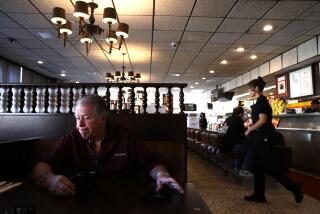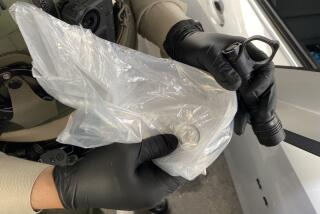down in the DUMP : Health Problems and Odors a Way of Life for McColl Site Neighbors
Milo Burdick stands in the back yard of his four-bedroom house and sniffs the McColl toxic waste site. “Smell that?” he asks. It’s a rhetorical question. There’s no escaping the odor, which is faint but unmistakable, just a bit unpleasant, hard to describe, not quite up to the sulfurous-bordering-on-rotten-eggs smell of a really bad night.
“I’ve woken up on a bad night and it makes you nauseous,” said Dave Bushey, who lives a few houses down the street from Burdick. “You’re half a step from vomiting; it’s that bad.”
The houses are nice here on the Fullerton streets with elegant names like Tiffany Place and Fairgreen Drive, two-story homes with more than 2,000 square feet, well-tended front yards displaying trees and bushes lined up as neatly as soldiers in an honor guard.
Burdick, a solidly built man of 51 with a weathered face, gestures to his back yard, but says, “We’re not out here much. We’ve got a pool, but what are you going to do with it?”
Not a lot as long as you’ve got that smell. Even without the smell, you’ve got the sight of black dirt-covered circles like a primitive culture’s burial mounds. You also have an ugly foot-wide gash of tar-like toxic waste rolling down a hill maybe 40 feet away from that pretty back yard.
It’s been 10 years now since the people near McColl learned that the unkempt swatch of land with the junked cars behind the houses was more than a place for drivers of off-road vehicles to roar the night away, more than just a run-of-the-mill dump, more than an eyesore that would be cleaned up someday, probably someday soon.
Some real estate agents said the unsightly area, next to the golf course of the private Los Coyotes Country Club, might become a park one day, a nice place for the children to play. The homes on Fairgreen commanded a premium for the golf course views.
But no developers, no real estate agents, no city or county or state officials told the residents what was beneath the ground, even below a part of the golf course: a legacy of the World War II years.
The dump was created in the 1940s, when oil companies producing high-octane aviation fuel deposited refinery wastes in sumps on land leased by oil industry consultant Eli McColl. Oil-drilling muds later were added to six sumps, which McColl eventually purchased.
The first people began moving into the area in northwest Fullerton, just south of Rosecrans Avenue, in the summer of 1978. They started feeling poorly soon afterward.
But at first they kept quiet, not wanting to drive the resale value of their homes down and counting on the city to neutralize whatever was in the dump or to clean it up and cart it away.
Then the state investigated and found that the material in the eight-acre dump was toxic; state health officials said the sulfuric acid, arsenic and benzene were not too dangerous to anyone right this minute, but in case of an earthquake or some other event that would unearth the waste, look out. The state made its findings public, and the demands for action started.
Homeowners might not have been falling over dead from the dump, but they knew they were having problems that their friends elsewhere didn’t have. They complained of headaches, nausea and coughing, eye irritation, fatigue, difficulty in breathing and inability to sleep.
Filtration systems or bottled water replaced water from the tap; air purification systems were installed; fences separating back yards from the dump sites began sprouting barbed wire. They waited for help. And waited. And waited.
They’re still waiting.
“We’re frustrated; we’re tired of it,” said Betty Porras, a leader of the battle to get the dump cleaned and get life back to normal. “It’s difficult to live with, day in and day out, when you’ve got something hanging over your head.”
Porras has been a member of the McColl Dump Action Group for four years and now is the group chairperson. She says the group has succeeded in letting various agencies like the state Department of Health Services and the federal Environmental Protection Agency know that someone is watching them and clamoring for action.
Yet she expresses frustration because “it’s taken so long. I feel that between politics and bureaucracy, it’s long overdue that it be cleaned up.”
Others have been worn down.
Cheryl Siegel moved into the house next door to the Burdicks in 1985, assuming that the dump would soon be cleaned up, as promised. She said she and her husband went to some homeowners’ meetings but quickly became frustrated at how many years the cleanup would take even if it started immediately. She became weary, too, of listening to the bureaucrats’ words that turned out to be empty.
“You get to the point where you can’t even stand to talk to these people,” Siegel said. “They just talk in circles. They have a standard pat answer that has nothing to do with the questions asked.”
“I’ve stopped going to meetings because they’re a joke,” Siegel added. “But thank God for people like Betty (Porras) to keep it going and keep a fire” at the feet of the bureaucrats.
Ironically, the Siegels moved from Seal Beach to Fullerton for health reasons: Their son has bronchitis and needed a dryer climate. Like everyone else, she said she would have moved somewhere else if she had known how many years would pass with the toxic wastes still in the ground.
Still, she loves being in the hills. “The area is gorgeous. If they ever clean up this mess, it would be nice. I just don’t know if in my lifetime it’ll be done. That’s what I say now. When we moved in, I don’t know if I would have heard myself saying that.”
The Siegels at least knew there was a toxic waste dump a stone’s throw from their back yard. Those who moved in during the late 1970s and early 1980s are unanimous in saying they didn’t know what was buried beneath the ground. Environmental reports spoke of possible noise from the Fullerton Airport a mile away. They didn’t speak of the dump.
As a result, lawsuits were filed against the developers who built many of the houses and against the city, which approved the construction, and the state and county for not stopping construction.
A first round of legal warfare ended in 1986, with 141 families getting settlements from various defendants in an agreement in which no liability was admitted. Attorneys said some families got up to $129,000 each, though those living farther from the dump and for lesser periods of time got less money. In all, defendants have paid out more than $14 million so far. A second round of lawsuits, brought by residents of more than 200 other nearby lots, nearly got settled two months ago but fell through at the last minute.
Some dump-area residents declined to be interviewed because of the pending lawsuit. Others declined because, as one put it, “we don’t want to seem to be looking for sympathy when we live in these nice houses with swimming pools.”
Yet others are willing to talk, are willing to battle, are willing to pressure the bureaucracy to clean up the mess.
“I don’t say I think about it every day--but you can’t help think about it if you’re on Rosecrans coming home or if you smell it,” said resident Joyce Cury. “You try not to think about what might be happening to you while you’re living here.”
Like many, Cury still loves the neighborhood. But if she had it to do all over again, “by all means I’d move somewhere else.” The lack of a cleanup has also shaken Cury’s faith in the way things are supposed to work in America.
“I’ve gotten my hopes up many times that it would be cleaned up, but I don’t believe them anymore,” she said. “I’m sorry to say that.” Yet even if something is done to restore Cury’s faith, some earth removed or incinerated, “I’ve come to the stark realization in the last six months that if it is (cleaned up), it’s going to be 20 years now, at the rate they’re going.”
Once, the cleanup was only days away from launch. Milo Burdick’s wife, Connie, turned over the first shovel in a symbolic gesture and proclaimed, “We did it, we really did it.” That was five years ago this month.
But the state couldn’t reach an agreement with the operator of the Santa Barbara County landfill where the waste was to have gone. Later in 1985, a judge barred dumping the refuse at a site in Kern County.
A canvas covering and earthen layers were eventually spread over the dump, reducing the noxious odors, but not eliminating them.
The Burdick’s daughter, Kyle, 1 year old when the family moved into their house on Tiffany Place, 6 years old when her mother turned over the shovelful of waste, is 11 years old now.
She has allergies, and Milo Burdick has respiratory problems of his own, he said, medical difficulties that he feels are worsened by the dump just over the back-yard fence.
“You’re talking about families, human lives, and it’s bad,” Burdick said, out back on the patio, near the two birdbaths, the resting deer statues, the swimming pool.
Suddenly he broke off and exclaimed excitedly, “Look at that. That’s a hawk. He’s a beauty, isn’t he? He’s been here since day one.” The hawk came to rest on a power pole and focused his eyes on the dump.
“A lot of birds eat off (the dump site) after (crews) clean it,” Burdick said. “Then they probably go off and die.”
The Burdicks were not one of the families that sued. Burdick said he didn’t want to be suing the people he was depending on to clean things up.
“We went along with what they said,” he remembered. “(They say that) they’re going to fix it. Hey, great! You listen to them, (maybe because) they’re saying what you want to hear.”
What the federal Environmental Protection Agency is saying now is that they might start incinerating anywhere from 100,000 to 275,000 cubic yards of contaminated soil on site at the dump in April. The process could take seven years to finish.
But there’s a problem. The federal government wants five oil companies it holds most likely to have been responsible for the hazardous wastes to pay for the cleanup. Once estimated to cost from $4 million to $7 million to dig up the dirt and truck it to a hazardous waste dump, the new estimate for incineration is anywhere from $160 million to $500 million. The site is on the federal “superfund” list, which has $8 billion to clean up toxic areas.
The oil companies say incineration is unproven, and leaving the waste where it is and covering it would be safer than excavation and incineration. The battle could lead to another court fight.
Meantime, residents beg for action and wonder who will buy their homes if they try to sell. Virginia Han, an agent for Merrill Lynch Realty, said she tried to sell a Tiffany Place house for the owners for more than four months, dropping the asking price from $329,500 to $317,500 but still getting no buyer.
The McColl dump is the main reason the house didn’t sell, Han said. “Someday if they clean that site, it’ll be a gorgeous area.”
Gene Brassett has been waiting for “someday” to become “today” for nearly the entire 12 years he’s been in his home on Fairgreen.
“My neighbor and I, for the first five years we were very, very involved in the whole mess, working with EPA and everybody,” Brassett said. “After five years, I have to work for a living, (my neighbor) has to work for a living, you just run out of time, you run out of energy. . . . I’m exhausted. It just wears you down.
“The government has unlimited finances and what seems unlimited time. It does wear you down, and you get to the point where you think, ‘Let somebody else do it now.’ I still go to the big meetings . . . but I’m not into the daily activities of monitoring what the government is doing.
“I guess frustration is the word that best describes the whole situation,” Brassett said, “because there’s just literally nothing we can do anymore. We’re in the grasp of bureaucracy.”
More to Read
Sign up for Essential California
The most important California stories and recommendations in your inbox every morning.
You may occasionally receive promotional content from the Los Angeles Times.






